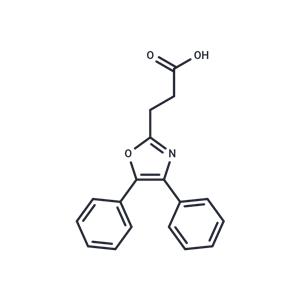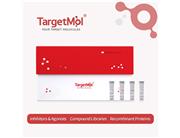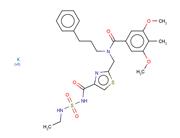| Name | Oxaprozin |
| Description | Oxaprozin (Oxaprozinum) is a Nonsteroidal Anti-inflammatory Drug. The mechanism of action of oxaprozin is as a Cyclooxygenase Inhibitor. The chemical classification of oxaprozin is Nonsteroidal Anti-inflammatory Compounds. |
| Kinase Assay | 9L cells are treated with drug for the times indicated in each experiment. Floating and attached cells are collected, pooled, resuspended in lysis buffer (10 mM HEPES buffer, pH 7.4, containing 2 mM EDTA, 0.1% CHAPS detergent, 5 mM DTT, 350 ng/mL phenylmethylsulfonyl fluoride, 10 ng/mL pepstatin A, 10 ng/mL aprotinin, and 20 ng/mL leupeptin) and lysed by three freeze-thaw cycles (alternating between a dry ice isopropanol bath and a 37°C water bath). Lysates are spun in a bench top centrifuge at full speed for 15 min and the supernatant (cell extract) fraction transferred to a new tube. Cell extracts (20 μL) are assayed for caspase 9, caspase 8, and caspase 3 activity by incubation at 37°C for either 1 h (caspase 3) or 3 h (caspase 9 and caspase 8) in 500 μL of reaction buffer (10 mM HEPES, pH 7.4, 2 mM EDTA, 0.1% CHAPS, and 5 mM DTT) containing 50 μM caspase form-selective substrate: Ac-LETD-AFC for caspase 8; Ac-LEHD-AFC for caspase 9; and Ac-DEVD-AMC for caspase 3. Background activity is determined for each sample as follows. Cell extracts are preincubated for 15 min at room temperature, with or without caspase form-selective inhibitor: 1 μM z-LETD-FMK for caspase 8, 1 μM z-LEHD-FMK for caspase 9, and 5 μL of Casputin for caspase 3. Caspase activity measured in the absence of inhibitor is divided by the background caspase activity measured in the presence of inhibitor. A value of 1 is subtracted from each measured activity, such that a caspase activity of 0 corresponds to no increase in the specific caspase activity with drug treatment. Fluorescence of the caspase product (excitation at 395 nm and emission at 525 nm for AFC substrates, and excitation at 380 nm and emission at 460 nm for the AMC substrate) is measured using a Shimadzu model RF-1501 spectrofluorophotometer and the manufacturer's PC-1501 software package. |
| In vivo | The anti-inflammatory effect of Oxaprozin is thought to be due to its inhibition of cyclooxygenases in platelets that block prostaglandin synthesis. This may be due to Oxaprozin's antipyretic effect on the hypothalamus, leading to an increase in peripheral blood flow, vasodilation, and subsequent heat dissipation.Oxaprozin has a lower selectivity for COX-2, implying a higher selectivity for COX-1. |
| Storage | Powder: -20°C for 3 years | In solvent: -80°C for 1 year | Shipping with blue ice. |
| Solubility Information | Ethanol : 26 mg/mL (88.6 mM)
DMSO : 55 mg/mL (187.51 mM), Sonication is recommended.
|
| Keywords | anti-inflammatory | NF-κB | IκB kinase | PKB | I kappa B kinase | COX | inhibit | Nuclear factor-kappaB | Cyclooxygenase | IKK | Akt | Protein kinase B | Nuclear factor-κB | Wy 21743 | Inhibitor | Wy-21743 | Apoptosis | NSAID | Oxaprozin |
| Inhibitors Related | Ibuprofen | Acetaminophen | Diclofenac sodium | Glucosamine | Diclofenac Potassium | Lidocaine hydrochloride | Indole-3-carbinol | Paradol | Indomethacin sodium hydrate | Diallyl disulfide |
| Related Compound Libraries | Bioactive Compound Library | Anti-Neurodegenerative Disease Compound Library | Pain-Related Compound Library | Anti-Cancer Clinical Compound Library | Drug Repurposing Compound Library | Inhibitor Library | Anti-Cancer Approved Drug Library | Anti-Aging Compound Library | Bioactive Compounds Library Max | Anti-Cancer Drug Library |

 United States
United States



